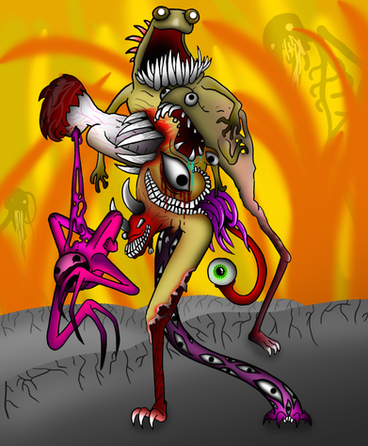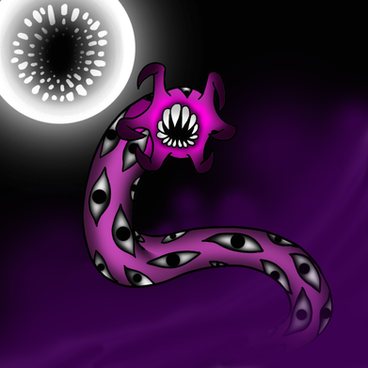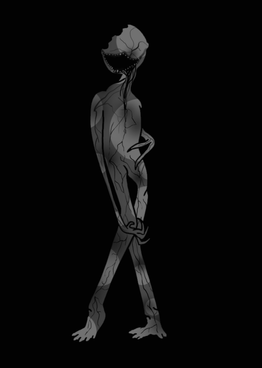HOME | DD
 detectOplasm — Gridgetown Anomaly
detectOplasm — Gridgetown Anomaly

#abstract #anomaly #biological #central #creature #dreamlike #ecosystem #extradimensional #extraterrestrial #mainframe #monster #subsystem #surreal #darksack100 #gridgetown
Published: 2020-09-19 07:11:56 +0000 UTC; Views: 636; Favourites: 14; Downloads: 1
Redirect to original
Description
The Gridgetown Anomaly is a powerful, otherworldly species built to survive an unconventional existence in our own realm. It is named for its first official manifestation, and became something of a source of cultural pride to local Gridgetown residents. After several decades, variants of the Gridgetown Anomaly have appeared in all manner of locales, but the species was already so synonymous with the town they would bear its name collectively and forever.The Gridgetown Anomaly (plural Gridgetown Anomalies) is an iconic creature. Its front half is a smooth blubbery mass, thick and densely packed around the central body and hardening (without losing flexibility) near the tips of its limbs into vaguely crustacean fingers. Its latter half, however, transitions to a swirling etherial spotlight that allows the creature to levitate off any surface it projects upon. In other words, it has limited flight only so long as its light shines down on a physical area. This light is not physical itself, but generates a strong windy current and causes a burning sensation when touched. This spotlight can be any color, but is commonly portrayed as red - the color of the original Gridgetown Anomaly.
The Gridgetown Anomaly is well anchored to the realm, but it is still a fundamentally different being. Because of this, it cannot assimilate this dimension's materials and draw nutrients from them, dooming it to starve on its own. To circumvent this death, the Gridgetown Anomaly generates smaller biological subsystems: primitive, half-formed blobs of etheric energy allowed to fill their hollow structure with elements from the current realm. These subsystems serve as links between the world and the central creature, consuming carbohydrates and beaming converted chemicals back to their master's body. The Gridgetown Anomaly requires energy to create and maintain each of these subsystems, and will create the most efficient number at any given time, weighing what it exerts vs what it gains. It guards each subsystem jealously, roaming above the landscape and descending to punish those who attack or kill its subsystems. The Gridgetown Anomaly's weaknesses are also its strengths: its foreign nature makes it highly resistant to physical trauma inflicted by native objects and moderately resistant to chemical damage, both of which it heals from over time as though resetting to an earlier state.
Subsystems trawl about the established territory, searching for easy and readily-convertible fuel They are weak, unstable beings, easily fought off or even dispelled by a human aggressor. Because of this, they do not target live meat, and chiefly search for processed food, fruits, drinks, or corpses, which they bite into chunks, absorb, and convert. Subsystems will flee from attackers, but will otherwise ignore people. They also do not understand property, and will not hesitate to consume food in a stranger's house, or even food in a stranger's hand. These interactions can be tricky as one tries to fend off the subsystem, as overtly violent actions attract the attention of the central creature.
Despite its behavior, the Gridgetown Anomaly is not a wise or self-aware being. Its lifestyle is largely reactionary, with the creature adapting to changing circumstances on the spot rather than planning for future ones. It does not think to itself that a problem may occur: whether the killing of its subsystems, the dwindling of food, or the strange and frightening weapon of an attacker. It simply experiences these problems as they arrive and responds smoothly. This behavior can be mistaken for wisdom and intelligence, but the creature only gains this ingenuity when forced to. In a relaxed, stagnant environment it remains unchanging, desiring only to perpetuate its existence.
Because of their largely neutral lifestyle, civilizations plagued by Gridgetown Anomalies may opt to co-exist with them, rather than fight them. A single anomaly and its collective subsystems are a nuisance at worst to any area wise enough not to provoke them. Should one require extermination however, it can be achieved by destroying all subsystems (and newly created backup subsystems) until the creature starves, or attacking and killing the creature itself. The latter is not recommended if subsystems still exist.
A subsystem without a master become independent, continuing to forage, but converting the food into raw mass. This increase in size unlocks a new behavior in the creature, and it eventually splits into two, each still desiring food and ready to continue the cycle. These independent subsystems no longer recognize the territory their master establishes, and can spread as far as they desire, integrating with the ecosystem and functioning as wholly autonomous lifeforms. Though they will only ever be pests, this cancerous lifestyle can far exceed the influence of the original creature.
Related content
Comments: 4

👍: 0 ⏩: 1

👍: 1 ⏩: 1

👍: 0 ⏩: 1

👍: 0 ⏩: 0




















